Good Evening,
I've been a long time lurker here and have finally gotten around to posting, so I'll start with "hello!"
I'm writing to ask if anyone here has run into any plate armor which weighs in excess of 100 pounds. For the past few months, I've been working on collecting armor data from as many sources as I have been able (books, museum websites, auction pamphlets, etc) which provide the weight characteristics of plate armor in public and private collections, and consolidating them into a spreadsheet to find mins, maxes and averages based on extant example, and also notes such as current location, ascension number, place of manufacture, marks, etc. (with the caveat that, as many museums and curators have noted, most are composites). So far, I've cataloged 254 armors: 128 head to toe (or head to shin for later examples), 42 three-quarter, 51 half-, 26 jousting and foot-tourney, and 7 parade armors. The dates of the specimens are approximately 1400 to 1660 (very broad, to be sure!).
What spurred me to do this was a fairly recent study which involved men in plated defenses running on treadmills to try to find how much energy is expended in armor. Take from the study what you will, but a curious statement seemed to be included in all of the news reports: "combat armor could weigh up to 110 pounds." This, to me, seems ludicrous. While I had read statements from museums and books that list about 50 to 55 pounds as the average, and my own study has found the 128 head to toe suits average at 51 pounds flat, with a min of 25 pounds 1 ounce for a particularly composited specimen and a max of 84 pounds for an Italian armor supposed to have belonged to Pallavicini (a three-quarter suit at the Met takes the weight crown at 86.5 pounds for combat suits), I have yet to find a combat armor which weighs over 90 pounds, much less 110. When I broke down the head-to-toe combat armor into weight bands of 10 pounds (inclusive), 84% of the armors sampled (108 out of 128) weighed less than 60 pounds (27.21kg), while 49% (63) were less than 50 (22.68kg).
The results of my study, of course, are VERY limited in scope. I understand well that 128 combat armors are not one-one hundred thousandth of the overall picture, but I do wonder where this figure of "up to 110 pounds" comes from? The heaviest armor I was able to find was a jousting (not combat) armor which has excess pieces on it in the form of lower leg protection at Higgins - perhaps formerly at Higgins, now that the armor is being moved to a new home - 2586.1.a-t weighs 98.41 pounds as configured. I recall reading somewhere that Churburg houses an exceptionally heavy suit, but I cannot remember where, nor can I find this suit. I am not an expert, but it would seem to me that such an armor would be a composite, made up of pieces from a jousting armor and perhaps sprinkled with parts from a combat suit and then labeled as a full-up combat suit by an unscrupulous collector. Alternatively, perhaps it would be a suit made for a truly immense person? But even that doesn't ring true with me because armor that heavy would make anyone combat ineffective extremely quickly!
Considering that I know I'm looking through a soda-straw at a wall-painting with my current numbers, I'd like to ask if anyone here knows of or has run into any examples of combat armor that do exist in the beyond-100 pound "ridiculously heavy" band? Is there any validity to that claim? Because right now, I see none.
Thanks in advance for any replies!
I assume the study referred to is Dr Graham Askew's research from the Proceedings of The Royal Society B.
in which case, all weights listed included that of a 6.3kg arming doublet, averaged out from the weights of two extant examples, Royal Armouries III.5, at 5.6kg, and III.8, at 7.0kg.
Harnesses used in the references were:
Churburg 18 (34.2kg)
churburg 19, (53.0kg.)
churburg 20, The "Avant" harness. now Glasgow Museums e.1939.65.e.1, (35.6kg)
Churburg 21 (38.6kg)
Royal Armouries II.1 (25.7kg.)
Royal Armouries II.3 (27.0kg.)
Wallace Collection A.20. (27.2kg.)
the "100 pound" harness, of course, being that of Ulrich von Matsch, churburg 19, who may, to paraphrase Hunter S Thompson, accurately be described as 'some kind of high powered mutant never even considered for mass production'.
note of course that ch.19 also has a great bascinet on it, as well as being built for the aforementioned mutant, though most of the harness is build for the field, not for the joust.
Askew's research was done with the assistance of John Waller, Graham Rimer, and Thom Richardson in the Royal Armouries.
in which case, all weights listed included that of a 6.3kg arming doublet, averaged out from the weights of two extant examples, Royal Armouries III.5, at 5.6kg, and III.8, at 7.0kg.
Harnesses used in the references were:
Churburg 18 (34.2kg)
churburg 19, (53.0kg.)
churburg 20, The "Avant" harness. now Glasgow Museums e.1939.65.e.1, (35.6kg)
Churburg 21 (38.6kg)
Royal Armouries II.1 (25.7kg.)
Royal Armouries II.3 (27.0kg.)
Wallace Collection A.20. (27.2kg.)
the "100 pound" harness, of course, being that of Ulrich von Matsch, churburg 19, who may, to paraphrase Hunter S Thompson, accurately be described as 'some kind of high powered mutant never even considered for mass production'.
note of course that ch.19 also has a great bascinet on it, as well as being built for the aforementioned mutant, though most of the harness is build for the field, not for the joust.
Askew's research was done with the assistance of John Waller, Graham Rimer, and Thom Richardson in the Royal Armouries.
Neil,
Your spreadsheet sounds like a handy reference - I am always wishing I had that kind of data all in one place. Would you mind sharing it? If not, send me a PM.
-Hildebrandt
Your spreadsheet sounds like a handy reference - I am always wishing I had that kind of data all in one place. Would you mind sharing it? If not, send me a PM.
-Hildebrandt
Agreed. A study of this sort would absolutely be publication-grade material if you were to expand your data to even a moderately significant fraction of extant examples.
James,
I am now better educated! Many thanks. I guess an armor that heavy does indeed exist, though it appears to be an uncommon happenstance. While I now know there is a 50kg monster out there, I'm still reluctant to accept a "30-50kg" range as "typical" when the majority of the suits I've cataloged don't break 27kg, and even with a 6.3kg doublet would still wind up at a lower ~23-30kg range (50-66lbs). Of course, I'm always willing to learn more, and as I said above, I'm no expert.
Jeffrey,
I'll fire it to you in a PM in its current state; at the moment I'm still working on it and it is liable to change if/when I'm able to find more examples.
Quinn,
I've considered publishing at some point, but I have some major hurdles to get over first. One is defining "significant" - I'm having trouble with figuring out what would be considered a "significant" or "moderately significant" number of armors surveyed, given the span of time plate harnesses were used, and how many were extant over time. 254 (of which 128 were head to toe) took several months to compile, but it's tough for me to say that even this amount is significant, given that there would have been more suits than this on a given battlefield on a given day in history.
I have been working on a variety of word documents to try to best describe the findings I have thus far; describing weight of a late medieval/early modern loadout versus a current one for a day patrol (given the averages at the current findings, they're darn close), weight variance across time, charts, etc. But, with only a BA, it's hard for me to think the study would have very much weight (no pun intended).
I'm also stifled by the search for documents that list object weights. In my survey at its current state, I have no examples from Churburg (barring the "Avant" armor, which is now in Scotland), nor the Landeszeughaus, Graz, both of which have renowned collections of armor, but I have been unable to find the weight statistics of objects in either collection. Hasn't helped get that 128 number any higher! (Though, thanks to James' post, some of that information is now revealed to me!)
We'll see what I'm able to find in the future. If I can pin down that number and find more examples, I might be able to produce something out of it.
I am now better educated! Many thanks. I guess an armor that heavy does indeed exist, though it appears to be an uncommon happenstance. While I now know there is a 50kg monster out there, I'm still reluctant to accept a "30-50kg" range as "typical" when the majority of the suits I've cataloged don't break 27kg, and even with a 6.3kg doublet would still wind up at a lower ~23-30kg range (50-66lbs). Of course, I'm always willing to learn more, and as I said above, I'm no expert.
Jeffrey,
I'll fire it to you in a PM in its current state; at the moment I'm still working on it and it is liable to change if/when I'm able to find more examples.
Quinn,
I've considered publishing at some point, but I have some major hurdles to get over first. One is defining "significant" - I'm having trouble with figuring out what would be considered a "significant" or "moderately significant" number of armors surveyed, given the span of time plate harnesses were used, and how many were extant over time. 254 (of which 128 were head to toe) took several months to compile, but it's tough for me to say that even this amount is significant, given that there would have been more suits than this on a given battlefield on a given day in history.
I have been working on a variety of word documents to try to best describe the findings I have thus far; describing weight of a late medieval/early modern loadout versus a current one for a day patrol (given the averages at the current findings, they're darn close), weight variance across time, charts, etc. But, with only a BA, it's hard for me to think the study would have very much weight (no pun intended).
I'm also stifled by the search for documents that list object weights. In my survey at its current state, I have no examples from Churburg (barring the "Avant" armor, which is now in Scotland), nor the Landeszeughaus, Graz, both of which have renowned collections of armor, but I have been unable to find the weight statistics of objects in either collection. Hasn't helped get that 128 number any higher! (Though, thanks to James' post, some of that information is now revealed to me!)
We'll see what I'm able to find in the future. If I can pin down that number and find more examples, I might be able to produce something out of it.
In serious earnest I beg you to develop this resource, publish, and/or put it online. The field of arms and armor is often long on rhetoric but short on accurate data and numbers, simply because the owners of all this armor are not necessarily sharing this information with each other or the public in a way that can be easily accessed. There are plenty of books and catalogs, but they are rare and expensive and it is difficult to use those to create a really good chart comparing the weights of armor in a similar category. If the category is cap-a-pie full plate armor, and if you narrow that down to field armor as opposed to joust or parade armor, then I think a sample size of over 100 is definitely enough to publish and draw some conclusions. True, the amount of armor that still exists is much smaller than all the armor that ever existed, and there's a small chance that our remaining sample skews either light or heavy from that unknowable historical average, but if it is so difficult to find extremely heavy armors in collections today then that is strong evidence that they were highly abnormal.
There may be a lot of expert curators out there who have this knowledge and information, but they are constantly busy and have their own fish to fry. The tools available to the general public and the amateur enthusiasts won't improve except through the ambition and sheer work of people like you.
There may be a lot of expert curators out there who have this knowledge and information, but they are constantly busy and have their own fish to fry. The tools available to the general public and the amateur enthusiasts won't improve except through the ambition and sheer work of people like you.
Thank you for sharing your work with me, Neil.
I think that this data is valuable even if it doesn't seek to be complete, "significant" or to validate a claim. A good collection of raw data like this is a goldmine. Add to this photos of armour backsides, insides, and a multitude of armour component thicknesses, and armour researchers will have to find something new to yearn for!
-Hildebrandt
I think that this data is valuable even if it doesn't seek to be complete, "significant" or to validate a claim. A good collection of raw data like this is a goldmine. Add to this photos of armour backsides, insides, and a multitude of armour component thicknesses, and armour researchers will have to find something new to yearn for!
-Hildebrandt
Where could I find any info on those 2 arming doublets (I already tried google)? Is it certain that they are meant to be used under a harness outside of a tournament? Their weight seems to imply unnecessarily many layers, or mail additions.
Wow, this information sounds very handy. I would love to get a copy of what you have so far if you don't mind. My personal armour reference library is pretty lacking right now.
Well, here's what I'll do. My most recent source arrived today (Fine Arms & Armor: Treasures in the Dresden Collection) and I'm skimming through it and adding to the list. Give me a few days and I'll compile the findings and spreadsheets into a document and post here. I'm adding in a few extra bits of information to cut down on search time and adding sources.
| James Moore wrote: |
|
in which case, all weights listed included that of a 6.3kg arming doublet, averaged out from the weights of two extant examples, Royal Armouries III.5, at 5.6kg, and III.8, at 7.0kg. |
James,
Where can we find out more about these doublets? These weights seem very high.
Mac
| Robert MacPherson wrote: | ||
James, Where can we find out more about these doublets? These weights seem very high. Mac |
Agreed, that was my first reaction too!
The info I have comes from the Proceedings of Royal society B paper itself, So my only suggestion would be to poke Thom Richardson at the Royal Armouries and ask him for info, not least as the RA's online collection data is being revamped just now...
James,
I searched a bit, but have not come up with anything online except the thing which you quoted already. https://www.google.com/search?q=royal+armouries+doublet&ie=utf-8&oe=utf-8&aq=t&rls=org.mozilla:en-US:official&client=firefox-a#q=royal+armouries+arming+doublet&rls=org.mozilla:en-US%3Aofficial
I am not aware of any arming doublets in the RA. If I recall correctly, they do have at least one doublet with eyelet holes stitched around metal rings. If they are counting that as an "arming doublet", it could explain the weight for at least one of the two.
Mac
I searched a bit, but have not come up with anything online except the thing which you quoted already. https://www.google.com/search?q=royal+armouries+doublet&ie=utf-8&oe=utf-8&aq=t&rls=org.mozilla:en-US:official&client=firefox-a#q=royal+armouries+arming+doublet&rls=org.mozilla:en-US%3Aofficial
I am not aware of any arming doublets in the RA. If I recall correctly, they do have at least one doublet with eyelet holes stitched around metal rings. If they are counting that as an "arming doublet", it could explain the weight for at least one of the two.
Mac
ALCON,
It took me a bit less time than I thought. I compiled the survey - the file includes a forward, charts for trending and weight breakdowns by bands, followed by a modern combat loadout for comparison, and finally the raw data. Only problem is that I can't upload as anything other than an image, and I think I wind up with about 17 of them and well over 200K of data. Any idea on how to post?
It took me a bit less time than I thought. I compiled the survey - the file includes a forward, charts for trending and weight breakdowns by bands, followed by a modern combat loadout for comparison, and finally the raw data. Only problem is that I can't upload as anything other than an image, and I think I wind up with about 17 of them and well over 200K of data. Any idea on how to post?
Think I found a solution until I can find a place to store the actual documents.
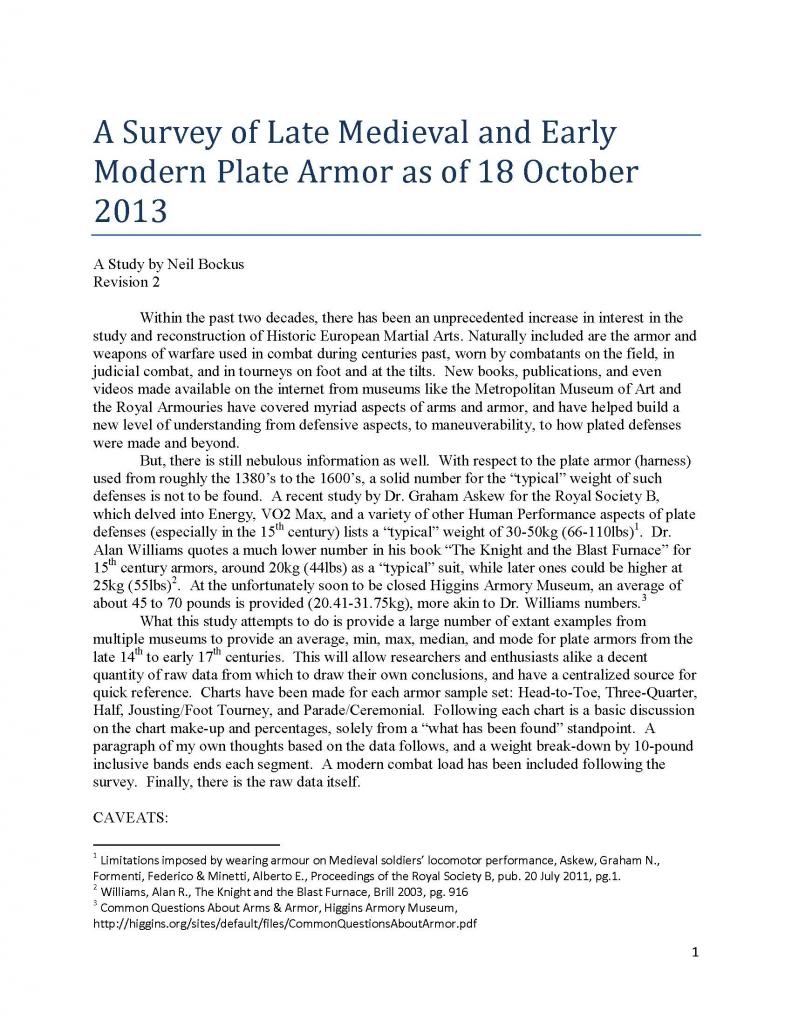
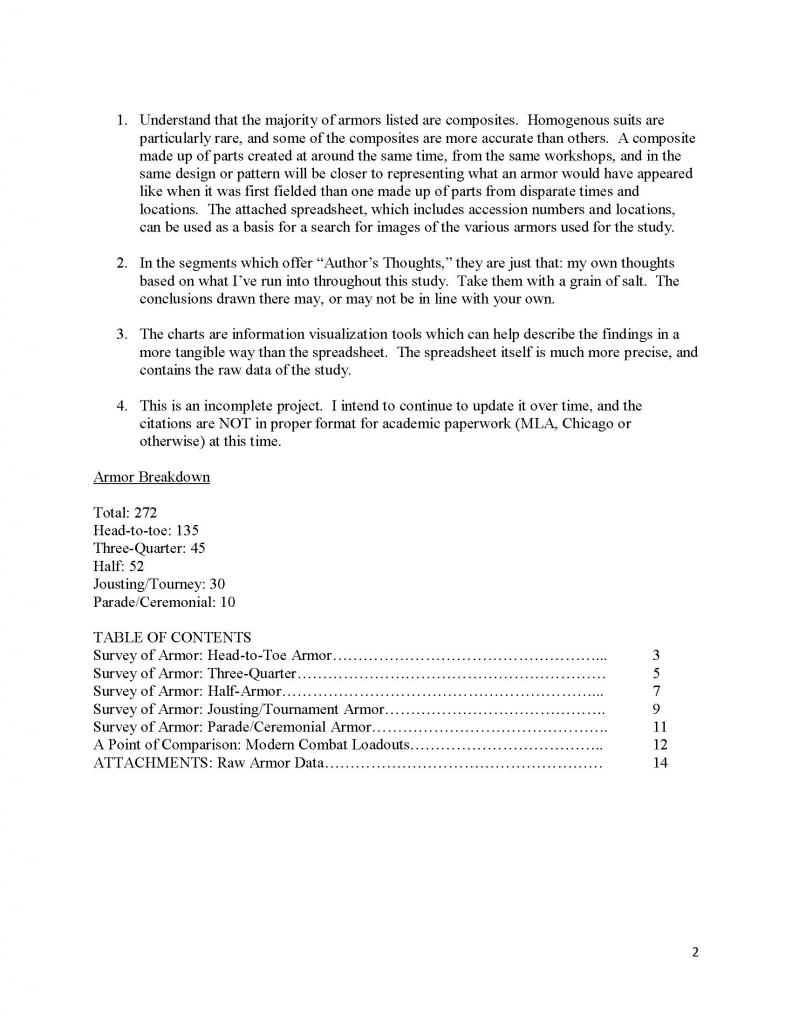
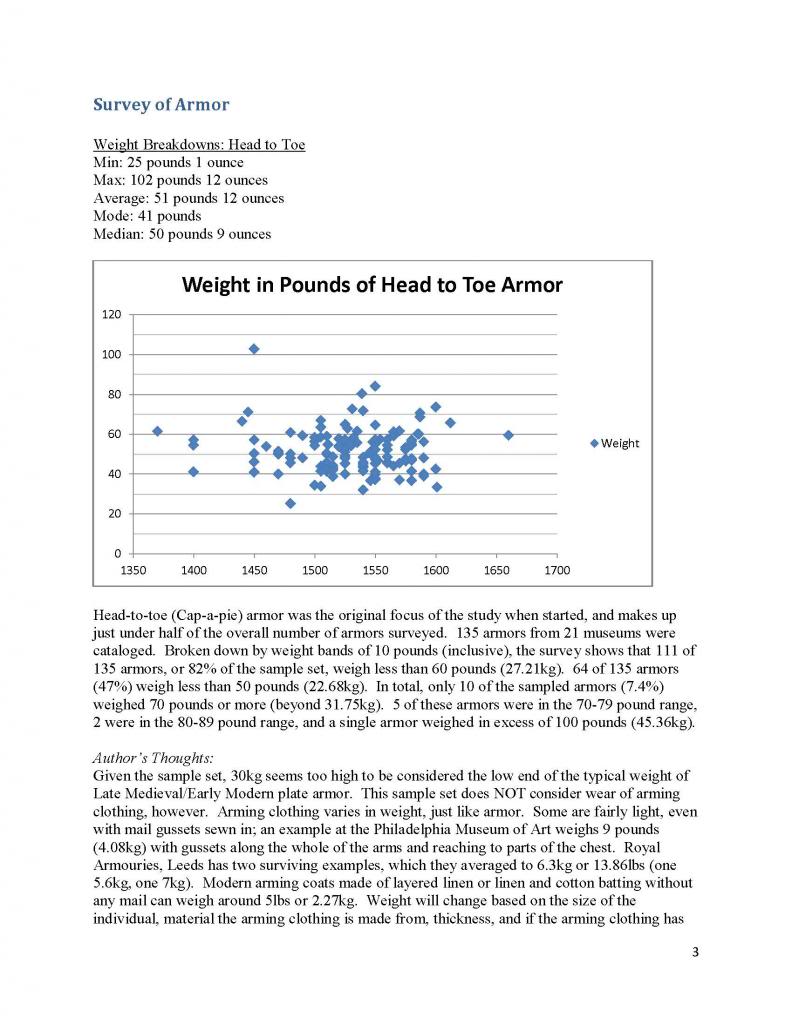

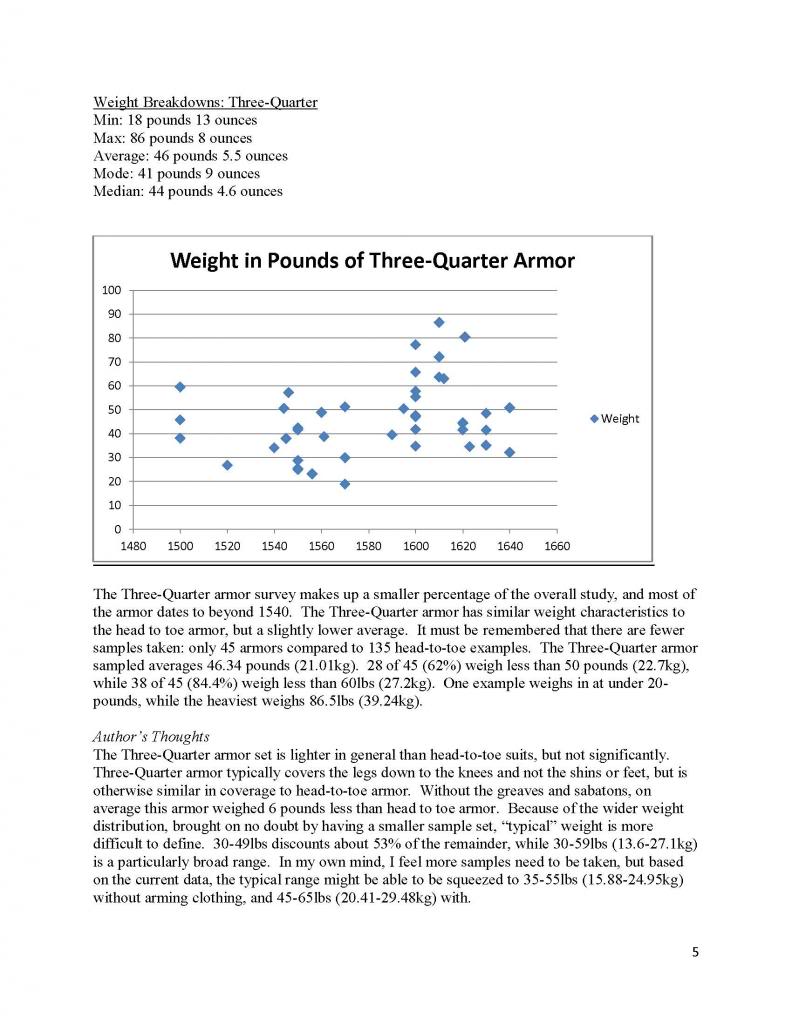
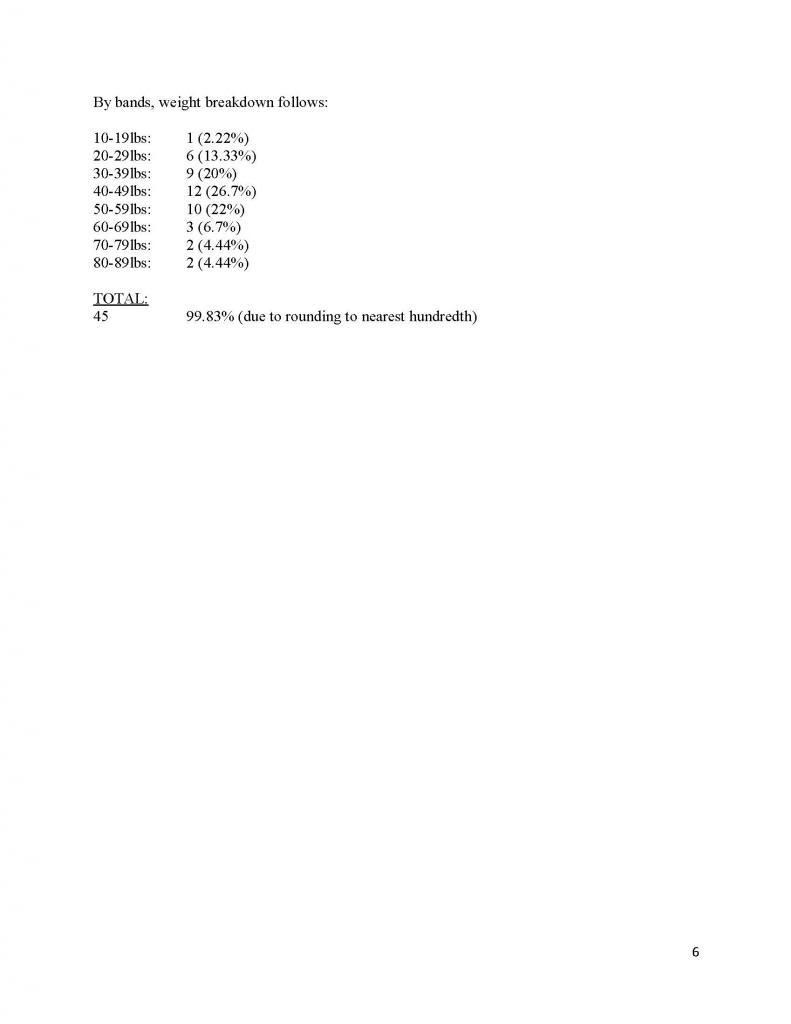
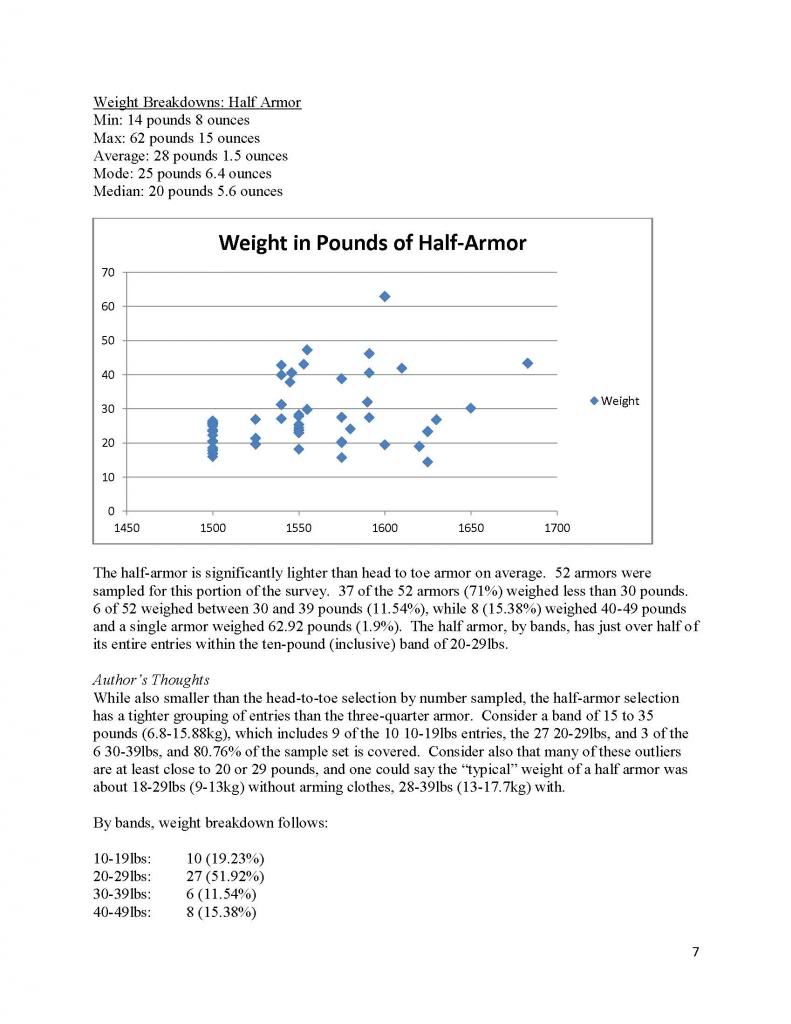

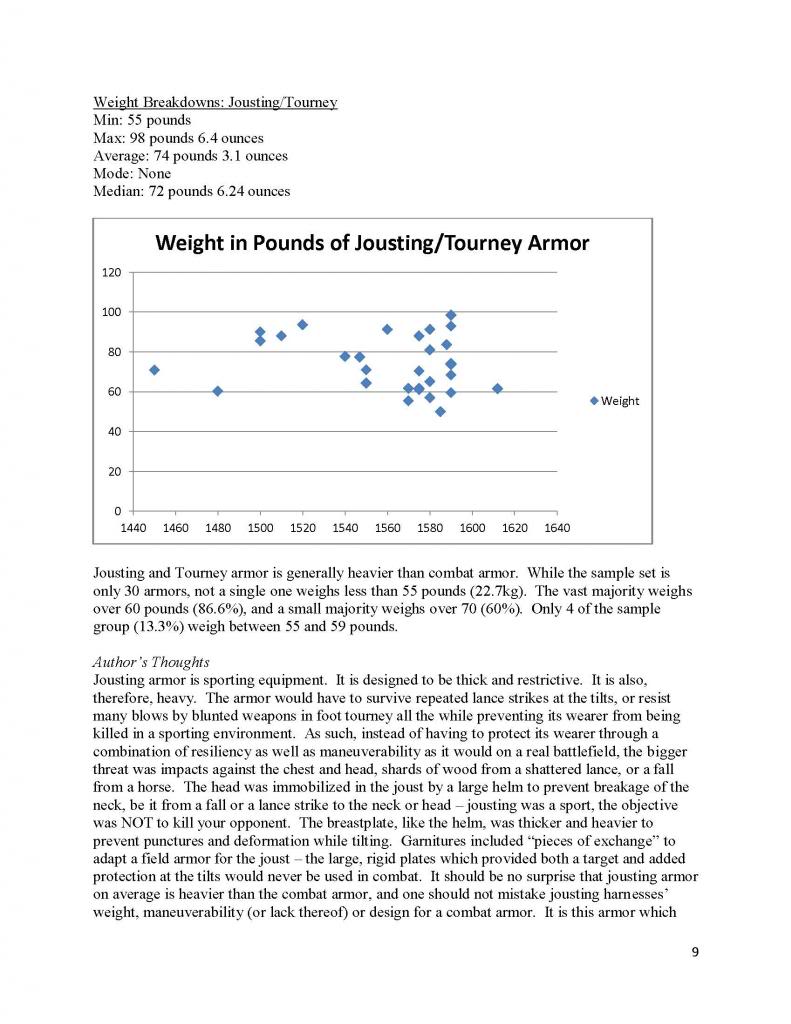

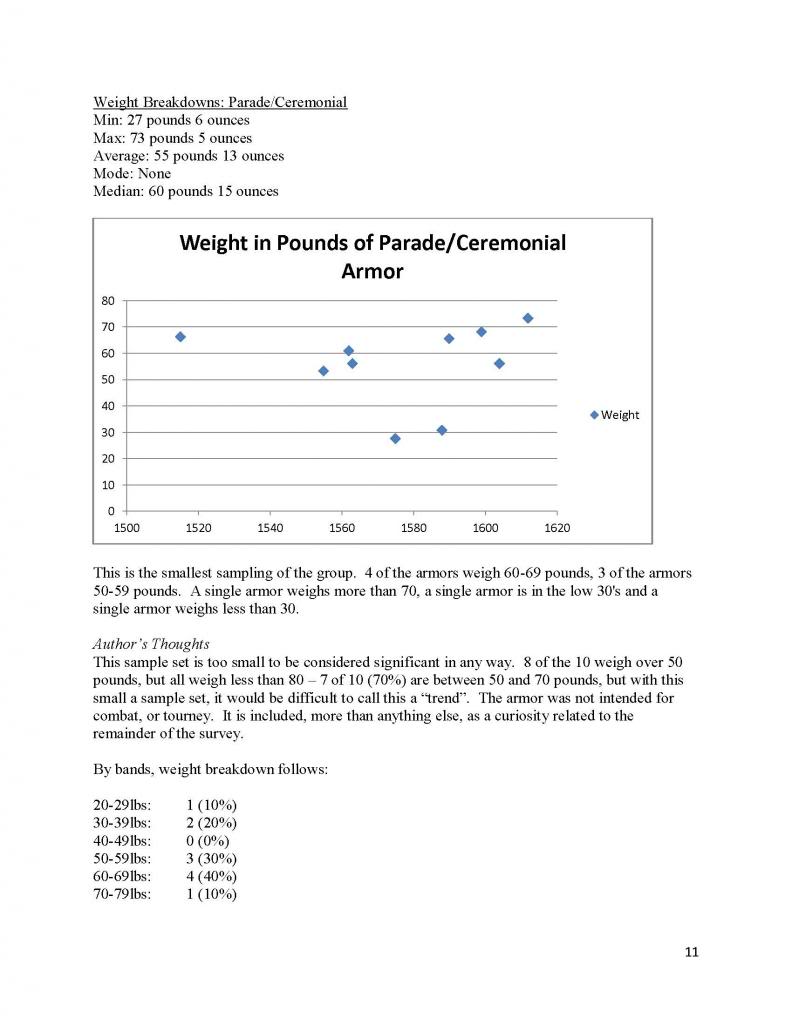
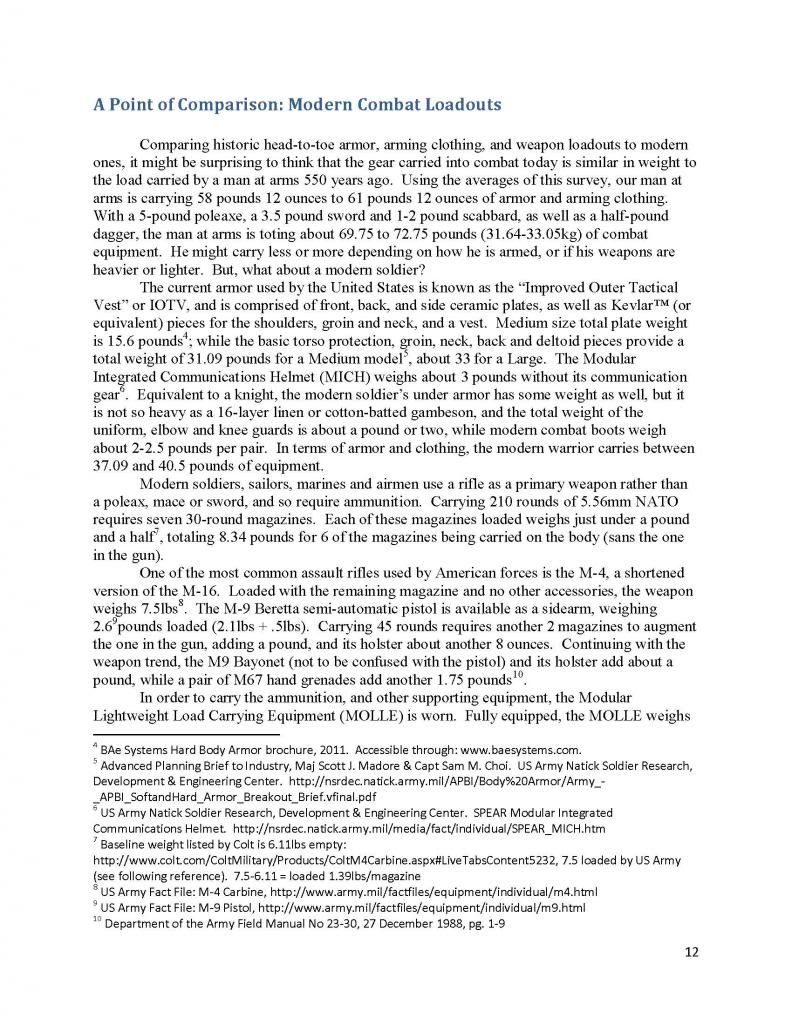
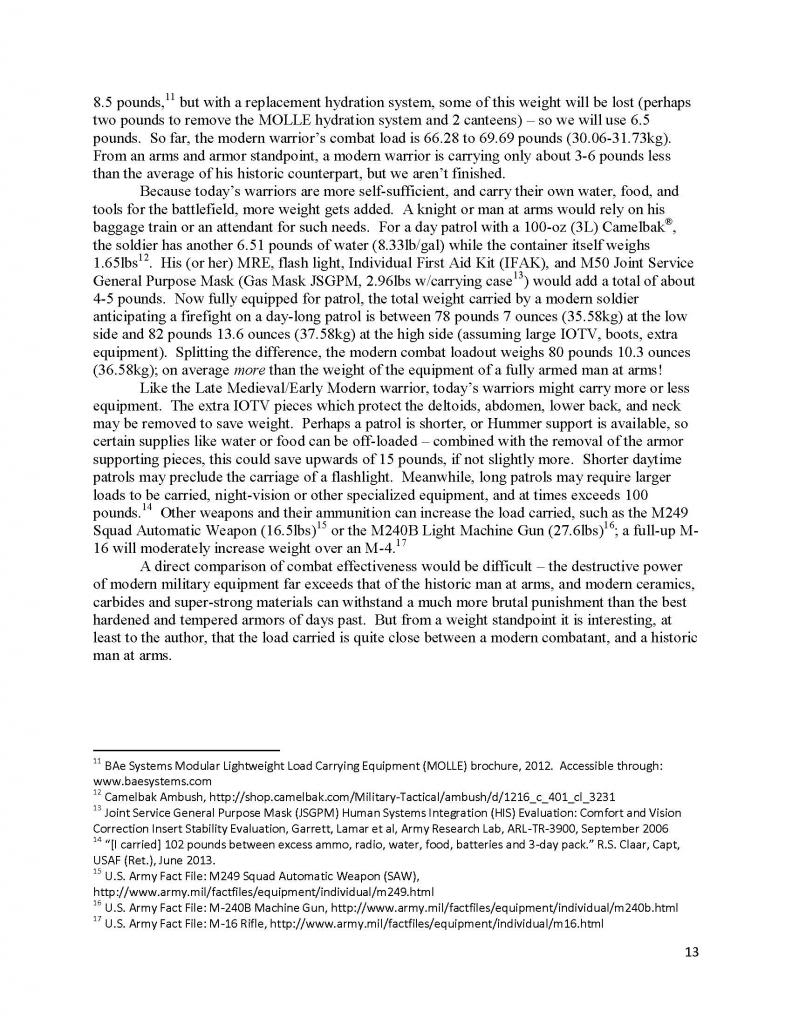
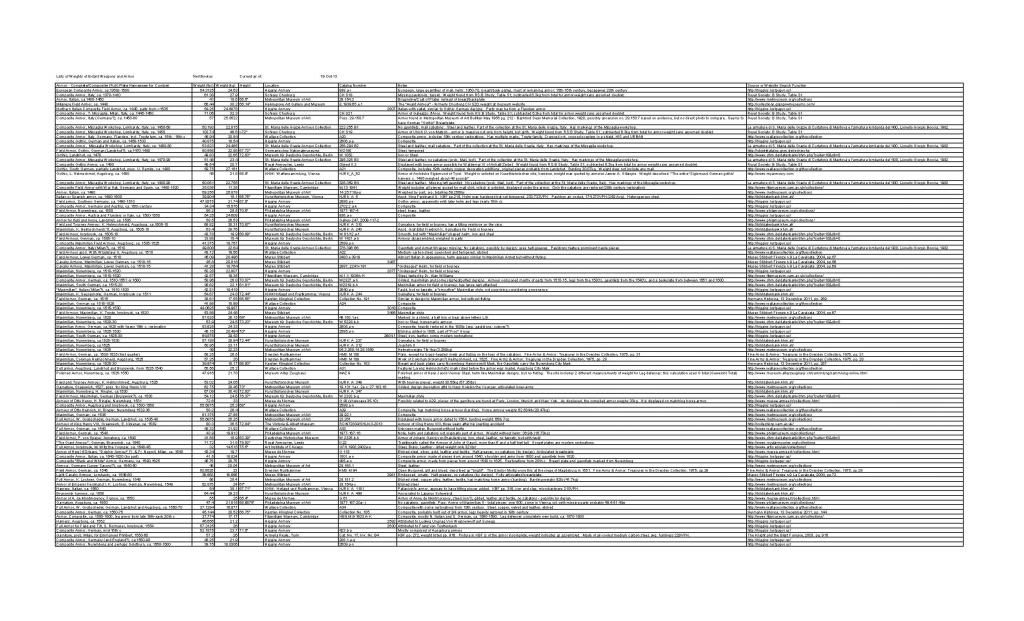
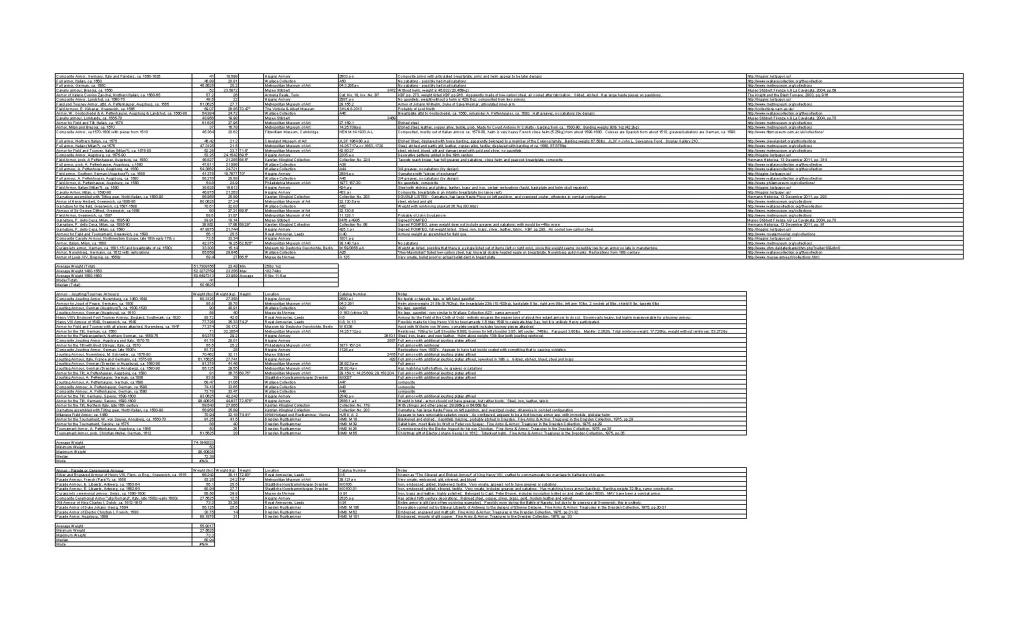
Will add last 2 in follow-on post (limit 15). Recommend saving targets for zoomability. PM me if you want me to send a .pdf or .xls.















Will add last 2 in follow-on post (limit 15). Recommend saving targets for zoomability. PM me if you want me to send a .pdf or .xls.
Last edited by Neil Bockus on Mon 21 Oct, 2013 3:04 pm; edited 1 time in total

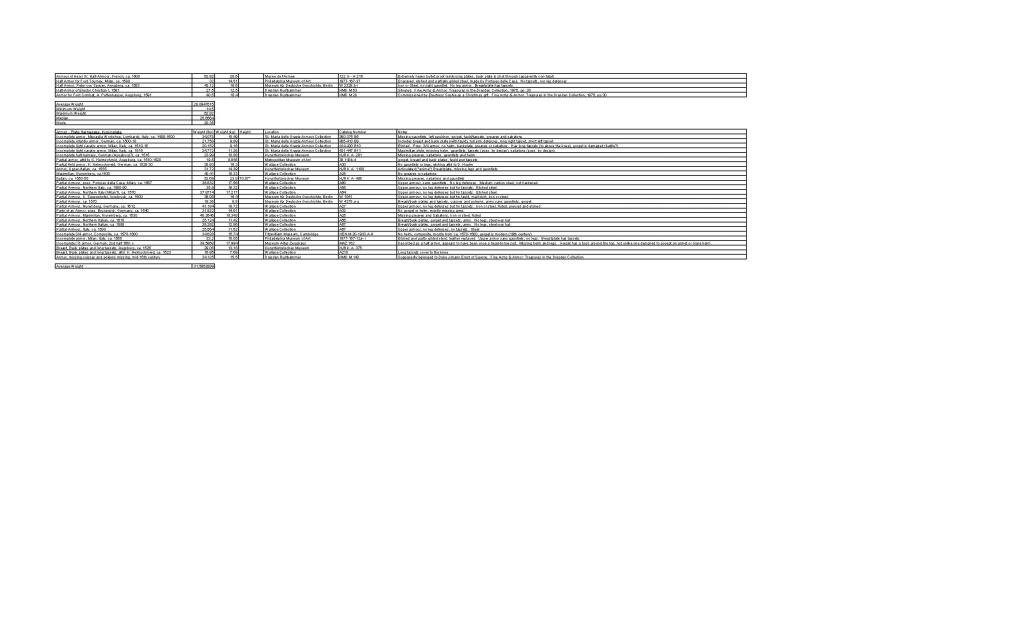
Final parts of the spreadsheets above.
- EDIT: Changed to revision 2, fixed grammatical errors and made a few tweaks.
Last edited by Neil Bockus on Mon 21 Oct, 2013 3:06 pm; edited 1 time in total
Very nice! :) I'm a data type guy and this information will give me something to chew on for quite a while.
Thank you very much for sharing your research.
Kindest Regards,
- Scott
Thank you very much for sharing your research.
Kindest Regards,
- Scott
Excellent work - thank you very much for posting!
ALCON,
I think I got the thing online using dropbox.
https://www.dropbox.com/s/0xqdwguj3o9ixsw/Armor%20Survey%20v2%2020131021.pdf
This is a link to the .pdf version of the document - I made a few tweaks, especially to the grammar. If it works, enjoy! If not, well, I'll have to find another solution.
I think I got the thing online using dropbox.
https://www.dropbox.com/s/0xqdwguj3o9ixsw/Armor%20Survey%20v2%2020131021.pdf
This is a link to the .pdf version of the document - I made a few tweaks, especially to the grammar. If it works, enjoy! If not, well, I'll have to find another solution.
| James Moore wrote: |
| I assume the study referred to is Dr Graham Askew's research from the Proceedings of The Royal Society B.
in which case, all weights listed included that of a 6.3kg arming doublet, averaged out from the weights of two extant examples, Royal Armouries III.5, at 5.6kg, and III.8, at 7.0kg. Harnesses used in the references were: Churburg 18 (34.2kg) churburg 19, (53.0kg.) churburg 20, The "Avant" harness. now Glasgow Museums e.1939.65.e.1, (35.6kg) Churburg 21 (38.6kg) Royal Armouries II.1 (25.7kg.) Royal Armouries II.3 (27.0kg.) Wallace Collection A.20. (27.2kg.) the "100 pound" harness, of course, being that of Ulrich von Matsch, churburg 19, who may, to paraphrase Hunter S Thompson, accurately be described as 'some kind of high powered mutant never even considered for mass production'. note of course that ch.19 also has a great bascinet on it, as well as being built for the aforementioned mutant, though most of the harness is build for the field, not for the joust. Askew's research was done with the assistance of John Waller, Graham Rimer, and Thom Richardson in the Royal Armouries. |
Apparently a lot of the weights listed in the Churburg catalogue are wrong. It seems to be a common flaw in a lot of catalogues. Its amazing how difficult it seems to be to simply weigh a piece of armour and record it accurately. Did Askew weigh the armours himself or rely on the data in the catalogues?
Page 1 of 2
You cannot post new topics in this forumYou cannot reply to topics in this forum
You cannot edit your posts in this forum
You cannot delete your posts in this forum
You cannot vote in polls in this forum
You cannot attach files in this forum
You can download files in this forum
All contents © Copyright 2003-2006 myArmoury.com — All rights reserved
Discussion forums powered by phpBB © The phpBB Group
Switch to the Full-featured Version of the forum
Discussion forums powered by phpBB © The phpBB Group
Switch to the Full-featured Version of the forum